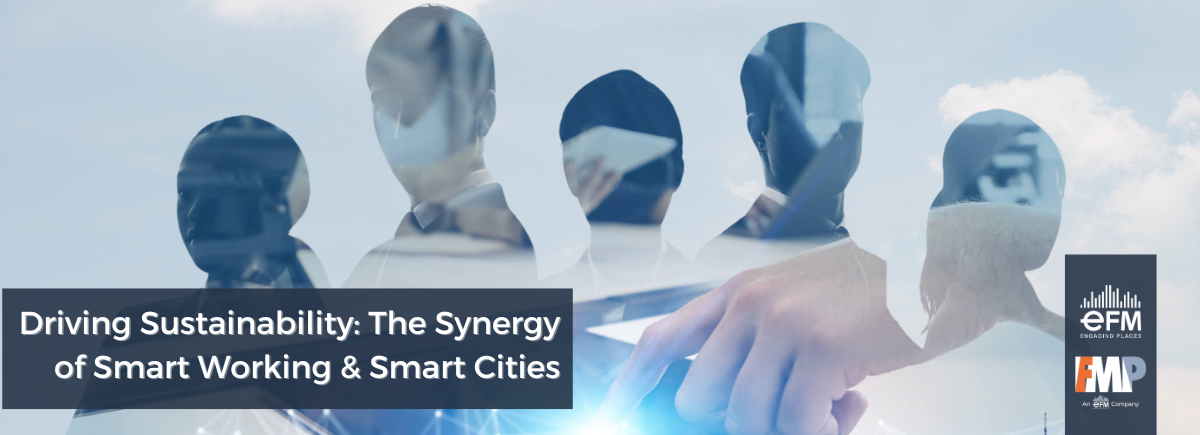
Driving Sustainability: The Synergy of Smart Working and Smart Cities
On Mar 28, 2024
Smart Working and Smart Cities can have a profoundly positive impact on people’s lives, enabling them to live better and work more satisfyingly. Moreover, these new smart paradigms empower administrations to efficiently manage public services and guide society towards significant sustainability goals. In today’s rapidly evolving landscape, the fusion of Smart Working and Smart Cities emerges as a powerful catalyst for sustainability. Primarily, environmental sustainability stands as a potent force capable of literally changing the world, enabling the tackling of today’s and tomorrow’s challenges: the depletion of natural resources, the progressive increase in population, and the phenomenon of urbanization, which will soon host up to 70% of the world’s population. Moreover, there is an ongoing discussion regarding economic and social sustainability to consider. Presently, the work-life model bears striking resemblance to that of thirty years ago, despite significant technological advancements. Properly embracing these innovations could pave the way for entirely new and sustainable practices, benefiting both the environment and “work-life integration.”
Based on these premises, it’s imperative to enact substantial transformations encompassing infrastructure, tools, methods, and the overall dynamics of work and life. Looking ahead, we must forge a fresh paradigm that prioritizes resource conservation and mitigates any potential wastage. Smart Working and Smart City initiatives stand out as two compelling solutions to address the burgeoning sustainability challenges on a global scale.
Smart Working, Smart City and the Benefits of the New Work Model
Smart Working represents the latest work model. Frequently mistaken for the telecommuting trend observed by millions of workers in recent years, smart working breaks free from fixed locations, rigid schedules, and strict attendance requirements. Embracing Smart Working means having the flexibility to work from anywhere. Moreover, it entails the freedom to select the most suitable location and tools for an optimal work experience, whether it’s a traditional office workspace setting, a designated meeting space, one’s residence, a coworking space, or even a library.
The impact on environmental sustainability is immense because it eliminates the daily double commute between home and office that has been the basis of work dynamics for decades. In this regard, it’s interesting to note that people – in the pre-pandemic era – spent about one hour per day commuting between home and work (source: Washington Post), and it is estimated that harmful greenhouse gas emissions from cars could be reduced by 54 million tons a year if US employees were able to smart work half the time (source: 2022 Global Workplace Analytics study). As for economic and social sustainability, consider the impact of smart working on companies: office occupancy decreases, services are utilized less, and opportunities for savings, to reinvest in the community and employee growth, become significant. Consider that, according to Digital Workplace Group, implementing smart working allowed British Telecom to save over $7,500 per year per employee.
Enhancing Sustainability Through Smart Cities
The concept of Smart Cities is experiencing rapid growth, with intriguing implementations already evident in numerous cities worldwide. Defining smart cities isn’t straightforward; they are essentially the outcome of a gradual integration of networks, IoT devices, and digital services into urban infrastructures. This integration aims to enhance connectivity between citizens, governments, and businesses while enabling innovative services. Smart Cities leverage the advantages of IoT and cloud technologies to gather and utilize data, thereby fostering sustainability, improving services for citizens, and enhancing business productivity.
There are dozens of areas in which the smart paradigm can be linked to the theme of sustainability. Here are some examples:
•Smart Management of Public Places
The ability to digitize areas allows for better planning, management, and monitoring of public spaces in the city, ensuring the availability of spaces in real-time, guiding people based on the interests, relationships, and experiences that the city itself can offer. Certainly an enabling factor for a new social sustainability with significant impacts also on economic aspects – efficiency and effectiveness of services – and environmental aspects – enhancement of existing unused spaces.
•Smart Traffic Management
Data collection systems and intelligent algorithms can determine a significant reduction in traffic congestion, with obvious benefits not only in terms of environmental sustainability but also economic and quality of life.
•Smart Grid
The union of an electrical distribution network and a decentralized computer network is at the core of the Smart Grid concept, which in turn is a key element of the Smart City. Smart Grid meets the needs of a world where energy distribution can no longer be that of the past: there are, and there will be more and more, many small energy producers from renewable sources (wind and photovoltaic plants) receiving energy from the grid but can also feed their own, creating a distributed model based on the absence of waste.
•Smart Lighting
Intelligent lighting is another pillar of the Smart City and an additional sustainability tool. IoT sensors can adjust street lighting intensity based on the context and prevent waste, but it is also possible to use energy from the lighting network to power value-added services such as charging stations, interactive kiosks, cameras, access points, and additional sensors.
Embracing Smart Solutions for a Sustainable Future
The convergence of Smart Working and Smart Cities presents a promising pathway towards a more sustainable future. By reimagining the way we work, live, and interact with our urban environments, we can unlock tremendous potential for environmental preservation, economic growth, and societal well-being. It’s imperative for corporate leaders to embrace these innovative solutions and lead the charge towards a greener, more efficient tomorrow. Let’s seize the opportunity to create lasting positive change for generations to come.